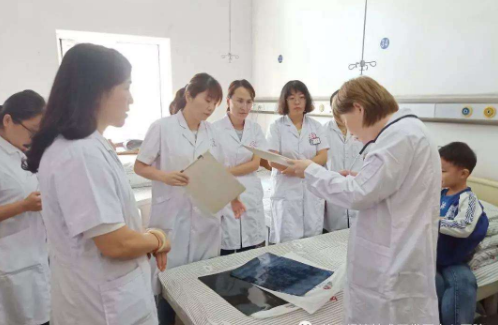摘 要
目的: 了解儿童狼疮性肾炎(LN)的临床表现、病理特点及预后现状,分析影响其预后的相关危险因素。
方法: 回顾性分析2012年1月至2018年12月于重庆医科大学附属儿童医院住院确诊为LN的220例患儿的临床及病理资料,并对其进行随访,将收集到的资料进行统计学分析。
结果: (1)220例LN患儿中,男性50例,女性170例,男女比例为1:3.4,患儿平均确诊年龄为10.94±2.49岁,发病高峰年龄在9~15岁。(2)LN的首发表现以蛋白尿最多见(81.36%),肾外表现以发热(65.45%)、皮疹(60.45%)最常见,除肾脏外,血液系统是最常见的受累系统(67.27%)。(3)儿童LN的临床分型以肾病综合征型最常见(57.14%),病理类型以Ⅳ型最常见(33.33%),Ⅳ型LN患儿活动指数(AI)显着高于Ⅲ型(P<0.001),Ⅳ型LN患儿24小时尿蛋白定量水平显着高于Ⅲ型(P=0.010),V型LN患儿e-GFR水平显着高于Ⅲ型(P=0.016)和Ⅳ型(P<0.001)。(4)1年、3年、5年的总体累积生存率分别为93.5%、87.8%、86.5%,5年的肾脏累积生存率为97.1%,最终肾脏缓解率为64.96%,肾脏复发率为23.47%。(5)感染为本中心LN患儿死亡的首要原因(50.00%),其次为神经精神狼疮(30.00%)。(6)在随访终点时进行整体病情评估,有34.31%的患儿达到不同程度的缓解,43.07%的患儿处于低疾病活动状态(LDAS)。(7)在LN诱导期的治疗方面,激素联合免疫抑制剂疗效显着优于单用激素(P=0.010),而环磷酰胺(CTX)和吗替麦考酚酯(MMF)的疗效差异无统计学意义。(8)单因素分析中,低蛋白血症(P=0.025)、血肌酐(P=0.015)、e-GFR(P=0.030)、抗ds-DNA阳性(P=0.045)、大量蛋白尿(P=0.035)、病初高血压(P=0.018)、神经系统受累(P=0.001)、治疗不依从(P<0.001)、SLEDAI-2K评分(P=0.011)、活动指数(AI)(P=0.014)均为影响LN患儿预后的因素。(9)经logistics回归分析结果显示病初高血压、神经系统受累、治疗不依从、e-GFR是影响LN患儿预后的独立危险因素。
结论: 本中心LN患儿最常见的表现为蛋白尿,Ⅳ型LN是主要的肾脏病理类型。LN患儿诱导期时使用激素联合免疫抑制剂疗效优于单用激素,CTX和MMF的疗效差异无统计学意义。感染为本中心LN患儿死亡的首要原因,其次为神经精神狼疮。病初高血压、神经系统受累、治疗不依从、e-GFR是影响本中心LN患儿预后的独立危险因素。
关键词: 系统性红斑狼疮,狼疮性肾炎,儿童,临床表现,预后。
ABSTRACT
Objective: To evaluate the clinical manifestations, pathological features and prognosis of pediatric lupus nephritis (LN), and analyze the risk factors that affect the prognosis of LN.
Methods: We performed a retrospective review of 220 patients who were diagnosed as LN in Children's Hospital of Chongqing Medical University during the period from January 2012 to December 2018. All data were analyzed by statistical software of SPSS 25.0.
Result: (1) Of the 220 patients enrolled in this study, one hundred and seventy (77.27%) were female and fifty (22.73%) were male. The female‐to‐male ratio was 3.4:1. The mean age at diagnosis was 10.94±2.49 years, and the peak age of morbidity ranged from 9 to 15 years old. (2) The most common manifestation of LN was proteinuria (81.36%), the most common extra-renal manifestations were fever (65.45%) and rash (60.45%).
Hematologic was the most common involved domain (67.27%) except the kidney. (3) The most common clinical classification of LN was nephrotic syndrome (57.14%), and the most common pathological type was Class Ⅳ (33.33%). Activity index (AI) of Class Ⅳ LN was significantly higher than Class Ⅲ (P<0.001). The 24-hour urine protein level of Class Ⅳ LN was significantly higher than Class Ⅲ (P=0.010), and the level of e-GFR of Class V LN was significantly higher than Class Ⅲ (P=0.016) and Class Ⅳ (P<0.001). (4) The 1-year, 3-year, and 5-year overall cumulative survival rates were 93.5%, 87.8%, and 86.5% respectively. The 5-year cumulative renal survival rate was 97.1%, the renal remission rate was 64.96% at the end of follow-up, and the renal flare rate was 23.47%. (5) Infection was the leading cause of death of LN in our cohort (50.00%), followed by neuropsychiatric lupus (30.00%). (6) At the end of follow-up, 34.31% of patients achieved different levels of remission, and 43.07% of them achieved low disease activity status (LDAS). (7) The efficacy of corticosteroids combined with immunosuppressive agents was significantly better than only corticosteroids as the induction therapy for LN (P=0.010), and there was no significant difference of the efficacy between cyclophosphamide (CTX) and mycophenolate mofetil (MMF). (8) In univariate analysis, hypoproteinemia (P=0.025), serum creatinine (P=0.015), e-GFR (P=0.030), anti-double-stranded DNA antibody positive (P=0.045), nephrotic-range proteinuria (P=0.035), hypertension (P=0.018), central nervous system involvement (P=0.001), non-compliance with treatment (P<0.001), SLEDAI-2K score (P=0.011) and activity index (AI) (P=0.014) were all risk factors that affect the prognosis of LN. (9) The results of multivariate logistics regression analysis showed that hypertension, central nervous system involvement, non-compliance with treatment and e-GFR were independent risk factors that affect the prognosis of LN.
Conclusion: The most common manifestation of LN was proteinuria in our cohort, and Class Ⅳ LN was the most common pathological type. The efficacy of corticosteroids combined with immunosuppressive agents was significantly better than only corticosteroids as the induction therapy for LN, and there was no significant difference of the efficacy between CTX and MMF. Infection was the leading cause of death of LN in our cohort, followed by neuropsychiatric lupus. Hypertension, central nervous system involvement, non-compliance with treatment and e-GFR were independent risk factors that affect the prognosis of LN in our cohort.
Keywords: systemic lupus erythematosus, lupus nephritis, children, clinical manifestations, prognosis 。
前 言
系统性红斑狼疮(systemic lupus erythematosus,SLE)是一种慢性自身免疫性疾病,约20%的SLE发生于儿童时期[1],儿童系统性红斑狼疮(pediatric systemiclupus erythematosus,p SLE)的疾病表现往往更加严重,尤其对于肾脏、神经系统、血液系统等多器官功能受累更为明显[2]。狼疮性肾炎(lupus nephritis,LN)是SLE最常见的并发症之一,也是目前较为常见的继发性肾小球肾炎,它影响着患儿的远期预后,其临床表现及病理类型多种多样,从无症状血尿或蛋白尿到肾病综合征,甚至部分患儿出现严重肾功能损害,给临床诊断及治疗带来困难。另一方面,现有SLE的全因死亡率分析显示,最近10年LN已经不是成人SLE的主要死因,Wu等[3]的研究显示感染及神经精神狼疮(neuropsychiatric systemic lupus erythematosus,NPSLE)成为导致SLE死亡的主要原因。
SLE疾病本身的高度活动及长期使用激素和免疫抑制剂的相关毒性均会对机体造成严重损害,在此基础上,为优化现有的治疗方法达到疾病长期稳定而提出了SLE达标治疗(Treat to target,T2T)[4],发展至今,成人SLE的治疗目标已较为明确,而T2T在儿科领域的应用仍未得到实践。
本研究对2012年1月至2018年12月于重庆医科大学附属儿童医院住院的220名LN患儿的临床资料进行回顾性分析及预后随访,分析其临床表现与肾脏病理的特点,探讨影响其预后的因素,以指导临床诊断治疗及改善预后,并根据T2T原则对本中心LN患儿的整体缓解情况进行评估,了解本中心的LN患儿的预后现状,对LN患儿的管理提供帮助。
1、资料与方法 。
1.1、研究对象。
研究对象为2012年1月至2018年12月于重庆医科大学附属儿童医院住院,年龄≤18岁明确诊断为LN的220例患儿,收集所有患儿首次住院期间的临床病理资料及后期的随访资料,所有患儿符合SLE及LN诊断标准。
SLE的诊断参照2009年美国风湿病学会(American College of Rheumatology,ACR)年会上SLE国际临床协作组(Systemic Lupus International Collaborating Clinics,SLICC)提出的SLE分类标准[5],患儿需满足分类标准中的4条,其中包括至少一条临床标准和一条免疫学标准;或有活检证实的狼疮性肾炎,伴有ANA阳性或抗ds-DNA阳性。
LN的诊断参照2010年中华儿科学会肾脏病学组制订的标准[6],诊断标准如下:
在确诊为SLE的基础上,患儿有下列任一项肾脏受累表现者即可诊断为狼疮性肾炎:
(1)尿蛋白检查满足以下任一项者:1周内3次尿蛋白定性检查阳性;或24小时尿蛋白定量>150mg;或尿蛋白/尿肌酐>0.2mg/mg;或1周内3次尿微量白蛋白高于正常值。
(2)离心尿每高倍镜视野红细胞>5个。
(3)肾小球和(或)肾小管功能异常。
(4)肾穿刺组织病理活检异常,符合狼疮性肾炎病理改变。
1.2 、方法。
1.2.1、回顾性采集患儿临床、病理资料。
(1)基本信息:姓名、性别、初诊年龄、首次就诊日期、病程长短、体重等。
(2)临床表现:有无发热、皮疹、光过敏、脱发、关节疼痛、神经系统症状、胃肠道症状、排尿情况、高血压等,根据SLE病情活动度表(systemic lupuserythematosus disease activity index 2000,SLEDAI-2K)[7]对患儿进行SLE活动性评分,0-4分为基本无活动,5-9分为轻度活动,10-14分为中度活动,≥15分为重度活动。
(3)实验室检查:白细胞计数(white blood cell count,WBC)、血小板计数(blood platelet count,PLT)、血红蛋白(hemoglobin,Hb)、尿蛋白、尿红细胞、尿白细胞、24小时尿蛋白定量(24h urinary protein,24h UP)、血肌酐(serum creatinine,Scr)、血尿素氮(blood urea nitrogen,BUN)、估算肾小球滤过率(estimated glomerularfiltration rate,e-GFR)、血清白蛋白(albumin,Alb)、谷丙转氨酶(alanineaminotransferase,ALT)、谷草转氨酶(aspartate aminotransferase,AST)、自身抗体、补体(C3、C4)、红细胞沉降率(erythrocyte sedimentation rate,ESR)、Coombs试验、骨髓细胞学、脑脊液检查、脑电图、心电图、头颅及胸腹部影像学检查等。e-GFR根据Schwartz公式[8]计算评估。
(4)临床分型:根据LN患儿的临床表现和实验室检查,分为7种类型:1)孤立性血尿和(或)蛋白尿型;2)急性肾炎型;3)肾病综合征型;4)急进性肾炎型;5)慢性肾炎型;6)肾小管间质损害型;7)亚临床型(无肾脏损害临床表现,但存在轻重不一的肾脏病理损害)。
(5)肾脏病理:LN的病理分型根据国际肾脏病学会/肾脏病理学会(ISN/RPS)2003年新修订的病理分型标准[9],共分为6型:Ⅰ型:轻微系膜性LN;Ⅱ型:系膜增生性LN;Ⅲ型:局灶性LN;Ⅳ型:弥漫性LN;Ⅴ型:膜性LN;Ⅵ型:严重硬化性LN。根据美国国立卫生研究院(National Institutes of Health,NIH)半定量评分方法[10],进行活动指数(activity index,AI)和慢性指数(chronicity index,CI)评分。
【由于本篇文章为硕士论文,如需全文请点击底部下载全文链接】
1.2、方法
2、结果
2.1、人口学资料.
2.2、临床表现
2.3、实验室指标
2.4、病理表现
2.5、随访结果.
2.6、预后分析
2.7、整体治疗目标评估.
3、讨论.
4、 结 语
SLE是一种多致病因素、多种机制参与的自身免疫性疾病,而LN作为SLE最严重的并发症之一,尤其是在儿童时期的LN中,影响着患者远期预后,LN的主要特征包括失去自我耐受性、自身抗体的产生、免疫复合物沉积和对肾脏的免疫修复损伤,导致细胞增殖增加、细胞凋亡,并诱导炎症和纤维化过程,破坏正常的肾单位。近年来对其免疫学发病机制的深入探索,有助于寻找新的治疗靶点,为LN的治疗提供新的思路。
参考文献.
